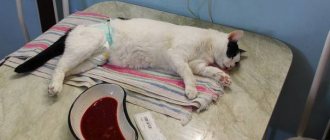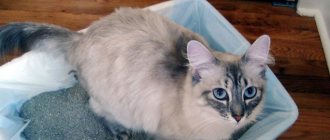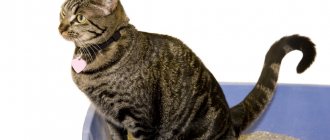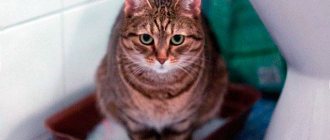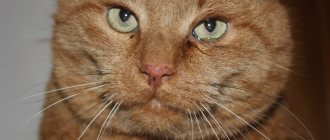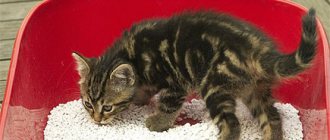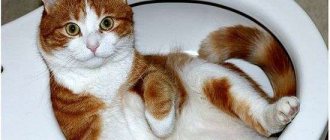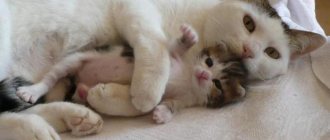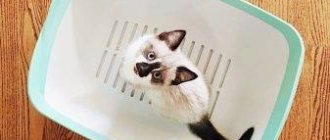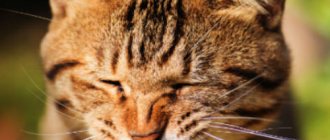Frequent urination in cats is called pollakiuria in veterinary medicine and can occur for a variety of reasons. This is a rather unpleasant condition, in which the main thing is to contact a veterinarian at the first sign in order to treat your pet as effectively as possible. Positive dynamics can only be achieved with an integrated approach, but if this condition is prolonged, then in the future there may be a lack of urination, which can lead to the death of the cat. In our article we will tell you why and under what diagnoses this condition can occur in cats, and how to treat it.
Urinary standards
Owners rarely pay attention to the amount of urine excreted by their cat. Veterinarians say that on average cats go to the toilet 3-4 times a day. However, the volume of fluid removed depends entirely on a combination of factors:
- Pet's age. Babies up to three months of age can write 1-2 times a day. This is explained by the special nutrition of the kitten - the main food is mother's milk, it is almost completely digestible and does not contain harmful compounds that require excretion. Therefore, the kitten does not urinate as often - and this is normal. When switching to natural food and drink, the kitten’s body secretes liquid 3 times a day. A teenager walks small 5-6 times, and an adult walks 3-4 times.
- Gender. Due to the different structure of the genital organs, the frequency of urination is different: males pee more often than females.
- Exercise stress. An energetic pet drinks more than lazy fluffies, and therefore will pee more often. A sedentary animal can generally visit the toilet 1-2 times a day.
- The volume of liquid drunk. During the hot season, the pet drinks a lot of water and, accordingly, goes to the litter box more often.
On average, the amount of urine excreted in cats is 50-200 ml per day. This volume should be significantly less if the cat is fed dry industrial food. This type of nutrition forces him to drink 2-3 times more than the volume that cats consume when feeding natural food.
Prevention
To prevent your kitten from having problems with urination, the following preventive measures must be observed:
- When feeding a cat with dry food, you need to monitor the amount of water you drink, that is, the kitten should drink 3 times more than the food consumed.
- It is necessary to provide the cat with movement. Inactive pets are more prone to diseases of the urinary system.
- It is necessary to ensure that animals do not gain excess weight, this is especially true for sterilized pets.
- You need to monitor your cats’ diet, excluding raw fish and meat, sausages, smoked and salted foods.
- Regular medical examinations will help identify the disease at an early stage.
- You need to get tested twice a year.
- You can give Kotervin 2 times a year - this drug has a preventive effect on the genitourinary system of the animal.
When a kitten urinates frequently and little by little, in this case, first of all, consultation with a veterinarian is necessary. Moreover, the sooner the cat is taken to the veterinary clinic, the faster recovery can occur. If contacting a specialist is delayed, there is a risk of acquiring a chronic form of the disease or even losing your pet.
Symptoms of pathology
Normally, the mustachioed friend does not experience discomfort when visiting the toilet: urine is released quickly, and the cat does not sit in the litter tray for long. If your furry one begins to linger in the toilet, going there more than 3-4 times, then you need to pay attention to the amount of water he drinks and the color of the urine. The following symptoms may be a cause for concern:
- during urination, the pet meows and experiences obvious discomfort;
- the pet has become lethargic and apathetic;
- urine has an unusual color and a pungent odor, sometimes blood appears in it;
- the number of trips to the toilet increases for no obvious reason;
- Always well-mannered, the cat suddenly begins to shit - this is due to the fact that the litter box causes him to associate with painful sensations;
- The cat often urinates in small portions.
Bright yellow or orange liquid or drinking too much water are not causes for concern - they are usually associated with high temperatures outside the window.
Extreme thirst and drinking too much water
If you cannot understand why your cat often goes to the toilet in small amounts, it is quite possible that the reason is the most commonplace - the animal simply drank too much water. The question is why the cat behaves this way. It's okay if the cause is hot weather, which causes the animal to quickly become thirsty.
But it is much worse if such thirst is provoked by diabetes. Only a veterinarian can accurately determine the cause.
There is no need to worry about heat, as this phenomenon is temporary and seasonal. It is enough for the animal to provide a cool place in the shade to avoid overheating of the body. If the cat urinates frequently at normal air temperatures and drinks an unusual amount of water, diabetes mellitus becomes a much more likely cause. This disease is diagnosed at a veterinary clinic using a blood test and some other tests.
Adult cats are most susceptible to diabetes, but in rare cases, the disease can also occur in kittens. also an increased risk of developing diabetes in obese animals . In addition, disruptions in the production of hormones, pregnancy, and estrus can lead to increased thirst. If you find that your cat frequently goes to the toilet in small quantities, you should not postpone a visit to the veterinarian, especially if the following symptoms appear:
- Urine with a distinct odor of acetone.
- Prolonged lethargic and apathetic behavior.
- Sudden weight loss (over several weeks).
- Vomiting several times a day.
- Excessive appetite, or its almost complete absence.
The sooner the owner of a sick cat contacts a specialist, the simpler and more effective the treatment will be. There is no need to postpone a visit to the veterinarian, because if the disease develops severely, it will be more difficult to help the cat, and no one will be able to guarantee successful treatment.
© shutterstock
When not to worry
Older individuals go to the litter box more times due to weakening of the muscles of the excretory system. So, if an old cat often pees, this is normal, give her a second litter tray, and the problem will be solved.
There are situations when a cat often pees simply because it drinks a lot. What can cause extreme thirst:
- the animal has eaten salty food (which, by the way, is strictly prohibited);
- the cat was switched to dry food - it is logical that he began to drink more;
- indoors or outdoors is too hot and dry;
- the pet ran around and played enough;
- the cat is undergoing treatment, and the prescribed drug severely dehydrates the body;
- The pet has been without water for a long time and now cannot get enough to drink.
All these situations are not dangerous - as soon as the thirst passes, the cat will return to the normal rhythm of going to the toilet. If an animal comes to water over and over again for no apparent reason, it is quite possible that it develops diabetes mellitus or has kidney problems.
And of course, there is no need to confuse marks and normal urination. The first ones have a pungent odor and are created by a cat in a standing position. The latter are accompanied by sitting down and do not smell as strong. An uncastrated cat can mark at least ten times a day - and this is not considered a pathology.
Stressful situation
This disorder can create serious problems not only for humans, but also for cats. Due to stress, immunity decreases, which can subsequently provoke infections and inflammatory processes.
A cat may find itself in a stressful situation due to sharply changed odors, a change in tray or sleeping place, a change in diet, moving, or the appearance of other pets.
The following symptom may indicate stress: the cat goes to the toilet little by little and often, and there is blood in the discharge. At the same time, there may be very little urine. A stressful situation can also be determined by the behavior of a cat - the animal will be very anxious, overly aggressive or, conversely, too apathetic. A cat can also communicate its stress by meowing loudly and frequently, periodically turning into a scream.
If stress causes your cat to pee frequently, a blockage in the urinary tract could even be one of the reasons. If this is the problem, you need to contact a veterinarian as quickly as possible - this condition poses a threat to the animal’s life.
© shutterstock
Causes of frequent urination in cats
Disturbances in the functioning of internal organs cannot be ignored, because they threaten serious health consequences, and in some cases, death. Pathologies are more common in older individuals, but the possibility of their development in young cats and kittens cannot be ruled out.
Cystitis
With cystitis, the mucous membrane of the bladder becomes inflamed, leading to impaired excretory function. The danger of the pathology is that at the initial stage there are practically no manifestations, and the disease passes into an acute or chronic form unnoticed by the animal owner. The main signs of cystitis are:
- frequent urination in small portions, sometimes drop by drop;
- restless meowing while going to the toilet;
- frequent licking of the perineum;
- hard hot belly;
- regular vomiting;
- dark color and pungent odor of urine;
- strong thirst;
- lethargy and fever;
Insufficient water consumption and poor quality dry food provoke the development of bladder dysfunction. Another cause of cystitis is hypothermia with subsequent transition to an infectious form. Less commonly, cystitis can be caused by helminths.
Urolithiasis disease
Disease of the excretory tract is typical primarily for obese males (this often happens after castration), as well as aging individuals. Recently, the pathology has also affected young animals receiving improper care and poor nutrition. The signs of ICD are:
- frequent urination little by little;
- severe pain during the process;
- progressive vomiting;
- weak appetite;
- unusual behavior of the pet: trying to hide or constantly following the person;
- heat;
- dark colored urine with sediment.
Kidney stones are formed due to poor nutrition with a predominance of calcium, potassium, phosphorus and purines. Cheap industrial feeds contain preservatives that cause illness. Hypothermia and subsequent infection cause inflammatory processes that negatively affect the cat's health. In females, urolithiasis also occurs, but much less frequently.
Kidney failure
A decrease in kidney function is mainly observed in older animals. Organs cease to function normally, as a result, metabolism is disrupted and all vital processes fail. Obvious symptoms of kidney failure:
- inactivity and lethargy;
- poor appetite and weight loss;
- unpleasant acetone odor from the mouth;
- dull coat;
- paleness of the mucous membranes, the appearance of wounds in the mouth;
- swelling is observed;
- extreme thirst and, therefore, frequent trips to the toilet;
- problems with stool - diarrhea or constipation;
- in severe cases there are convulsions and vomiting of blood.
The owner needs to show the cat to the veterinarian and begin treatment according to his recommendations. The animal is suffering greatly, so it needs help as soon as possible.
Diabetes
The pathology is associated with insufficient absorption of glucose by the body. A decrease in the concentration of certain substances in the blood makes the pet want to drink more water.
Overweight pets are most susceptible to diabetes. Pregnant cats are also at risk due to possible hormonal imbalances. In addition to constant thirst, other symptoms of diabetes include:
- weight change;
- abnormalities in appetite: increased or decreased;
- lethargic, apathetic state;
- frequent vomiting;
- smell of acetone from the mouth.
All factors are independent of environmental conditions: for example, an animal may feel thirsty even during cold weather. The cat pees frequently and profusely, but this is not accompanied by a feeling of pain.
Urinary incontinence
A weakening of the bladder sphincter leads to urine leakage - even if it is only a little. This is called incontinence. Many elderly castrati suffer from this problem. It also occurs with chronic infection or spinal injuries.
The pet begins to pee in small portions in different places. Urine is bright yellow in color, without a pungent odor. The process of urination does not cause pain. At the same time, the cat realizes that he wrote in the wrong place, so he tries to hide from the owner’s anger.
You should never scold an animal! The problem can be solved with diapers, disposable diapers and medications prescribed by the veterinarian.
Manifestation of stress
Nervous shock is a common cause of pollakiuria. It can appear in pets of different ages and breeds. Stress in a pet is usually caused by the following factors:
- moving to a new place of residence;
- a new tray or litter with an unusual smell;
- dietary changes;
- changes in relations with the owner;
- the appearance of another pet or child in the family;
- Emergency in the house: fire, burst water pipe, etc.;
- the arrival of too noisy guests.
In the vast majority of cases, the problem disappears after the cat gets used to the new circumstances. Prolonged illness, which lasts 5-7 days, may be the cause of a more complex disease.
The cat marks the territory
Males leave marks in different parts of the living quarters to show the boundaries of their place of residence. To do this, the cat often pees from a standing position in small quantities on walls, doorframes, floors, pieces of furniture, outdoor shoes and people’s clothes. This behavior is associated with natural instincts, which begin to worsen under the following factors:
- desire to attract a female;
- sexual desire;
- defending leadership status;
- revenge against the owner.
This behavior is most often exhibited by sexually mature males. There are different ways to cope with the problem, but castration of a cat under the age of one year is recognized as the most optimal method.
A cat can also leave marks, especially during heat. If you do not plan to breed kittens, the best and most humane way to stop marking is neutering. When in heat, a cat not only often pees in the wrong places, but also meows loudly. This irritates all family members, and the female’s body is exhausted, and nodules and tumors can form on the walls of the uterus.
Reasons why pollakiuria may occur
The reasons why a cat begins to visit the toilet frequently, and urine output is insignificant, can be pathological and physiological. In the first case, the animal requires treatment, and in the second, the phenomenon is considered normal and should not cause concern.
If the owner cannot independently understand whether the animal is sick or not, consultation with a veterinarian is required, and urgently.
Be sure to read:
Diarrhea in a kitten: what to do, first aid, causes, treatment, medications and folk remedies
Many diseases of the bladder, kidneys, and metabolic diseases can be treated quite effectively, but if detected at an early stage. Some pathologies are chronic and the animal requires regular maintenance therapy.
What is cystitis and why does it appear?
The main reason for frequent visits to the toilet, when there is little urine left in the tray, and sometimes it is mixed with blood, is cystitis. This inflammatory disease of the bladder does not occur without provoking factors.
Cystitis occurs as a primary pathology or complication. Depending on this, the necessary therapy is determined.
The development of cystitis in cats can be provoked by:
- disturbance of metabolic processes in the body (most often observed in old animals);
- suffered a severe infection;
- the presence of stones and sand in the kidneys, ureters or bladder;
- disturbance in mineral balance;
- improper nutrition, in which the cat does not receive enough proteins and fluids;
- infection of the genitourinary system;
- pregnancy and childbirth (cystitis can occur as a complication);
- cold.
Abdominal injuries can trigger the development of cystitis in a cat. This phenomenon is more typical of animals that have free access to the street, but can also be observed in apartment pets during unsuccessful jumps from a height.
The main reason for frequent visits to the toilet is when there is little urine left in the tray, and sometimes it is mixed with blood
With cystitis, a cat not only experiences frequent urination, but also meows when going to the toilet, as the process is accompanied by pain. Due to pain, the pet's behavior when trying to touch its stomach becomes aggressive.
Urolithiasis disease
Urolithiasis occurs in most older pets and some young ones. The risk of pathology in neutered cats that receive improper nutrition increases slightly. In this case, the owners themselves are to blame for the fact that the animal begins to get sick.
For neutered pets, you should use only special ready-made food or coordinate their natural diet with a veterinarian.
Stones not only injure the mucous membrane, causing irritation and inflammation, but also lead to blockage of the ureter, which impairs the flow of urine. If urine stagnation occurs and the cat does not receive emergency treatment, it dies within a few days.
The fact that an animal has urolithiasis can be guessed by its too frequent visits to the tray, during which urine is excreted in small quantities mixed with blood.
At the same time, the general condition of the animal worsens. A complete lack of urination is an emergency condition when you cannot postpone a visit to the veterinarian even for a day.
Be sure to read:
Black feces in a cat: normal or pathological, when is it a dangerous symptom, diagnosis, how to treat
Urolithiasis develops slowly. First, sand deposition begins in the kidneys. It does not interfere with the flow of urine and rarely causes any symptoms. Remaining in the kidneys, sand becomes compacted over time, and stones begin to form.
Fractions increase gradually. Small in size, they pass through the ureters and are partially removed in the urine. If treatment is not started at this stage, the stones will enlarge and cause health problems for the pet.
If your cat goes to the toilet frequently due to diabetes
Cats with diabetes also experience increased urination . At the same time, the animal's thirst increases. The cat begins to drink excessive amounts of water and, as a result, the need to visit the litter box increases.
The kidneys suffer from high levels of glucose in the blood and cannot cope with the load. As a result, despite the increased urge, the volume of urine released decreases. Treatment of the animal requires comprehensive treatment.
Risk group
Disturbances in the functioning of the genitourinary system are observed closer to old age, that is, after 8-10 years. It is believed that males more often suffer from kidney problems, and females more often suffer from cystitis and incontinence. This is true, but the cat may well get urolithiasis, and the cat may get cystitis.
Unvaccinated cats are at risk because their bodies are more vulnerable to viral and bacterial attacks. Annual vaccination significantly reduces the risk of any disease.
Some breeds are also susceptible to genitourinary problems: British, Scottish Fold, Persian and Siamese cats. This is explained by their anatomical features.
Do not forget that an obese animal is also at risk. Excess weight can trigger the development of diabetes and kidney disease.
Symptoms of urinary incontinence in cats
Signs of uncontrolled urination in cats are easy to spot. They are directly related to the reasons why the cat began to urinate more often than usual. As a rule, this is constantly wet fur on the inside of the thighs, on the stomach and under the tail, wet spots in the places where the pet has just sat or stood.
INTERESTING TO KNOW: Symptoms and treatment of colitis in cats
Embarrassment can happen at any time: both in a dream and during wakefulness, when the pet does not have time to run to the toilet. In this regard, the behavior of the animal changes. A cat, which is naturally clean, realizes that it has peed in the wrong place and becomes depressed and frightened. And if the owner also begins to violently express indignation at what happened or punish the pet, then another problem will be added to one problem - a stressful state.
When the disease is infectious, the cat urinates and experiences pain. The pet begins to meow pitifully. And a paralyzed cat, which walks on its own, does not even understand that its urine is released voluntarily.
If there is blood in the urine
The appearance of blood in the urine (hematuria) indicates that the cat requires treatment as soon as possible. The causes of hematuria are always associated with serious injuries or diseases of the genitourinary organs:
- damage to the walls of the bladder or urethra by a kidney stone;
- severe blow or injury to the lower back;
- advanced cystitis;
- tumor or oncology;
- reaction to the medicine.
Each of the cases requires urgent treatment - without it, the cat faces death.
Diagnostic methods
If your cat pees profusely and frequently and there are changes in its behavior, you should consult a veterinarian. Such symptoms are often a signal of the development of serious health problems. To find out the reasons why your cat has a frequent urge to urinate, you need to undergo some veterinary examinations, such as:
- laboratory testing of urine and blood;
- ultrasound diagnostics of the pelvic organs;
- x-rays of the bladder;
- analysis for blood glucose and the presence of acetone.
Diagnosis and treatment
Only a specialist can make an accurate diagnosis and prescribe the correct therapy. The owner may well confuse cystitis with urolithiasis, and diabetes with a viral infection.
After talking with the owner, the doctor will send the animal for examination. He will appoint:
- blood and urine tests;
- Ultrasound;
- X-ray;
- test for glucose or acetone levels.
The results of the examination will show a complete picture of the disorder and help find the cause of its occurrence. Without tests, even a doctor with many years of experience will not undertake to make an accurate diagnosis.
treatment for frequent urination in a cat include
- a course of antibacterial agents to eliminate inflammation;
- pain relief with painkillers;
- use of vitamin and mineral supplements.
Depending on the disease that caused pollakiuria, the doctor may prescribe other medications. The owner of a tailed patient must strictly adhere to medical instructions and not engage in self-treatment.
If an ultrasound or x-ray shows kidney stones, surgery or a laser procedure may be needed to break up large stones.
To normalize the condition of the mustachioed friend, a therapeutic diet is prescribed, which completely excludes foods that provoke illness. The pet needs to be given increased attention, patience and tenderness. It is advisable to limit the patient’s communication with other residents of the house or apartment.
Complex chronic diseases (diabetes, kidney failure) will require efforts from the cat’s owner: he will have to provide supportive treatment for the rest of the animal’s life. The chronic cat needs to be shown to the veterinarian more often and taken regularly for examinations.
To avoid such trouble, it is wise to take care of the mustachioed’s health in advance - follow preventative measures, feed with high-quality food and take good care in general.
Treatment: what to do and how to help the cat?
If a problem is detected, you should consult a doctor who, after a comprehensive examination, prescribes appropriate treatment.
Frequent urination in cats should not be ignored, since complications develop very quickly and can cause death. Therapeutic measures are selected by the veterinarian individually for each pet after conducting a comprehensive examination and identifying the cause of the problem. The table presents methods of treatment for disorders of various nature, as a result of which the cat develops frequent urination:
| Problem | Therapy |
| Urolithiasis disease | Inserting a catheter into an animal under general anesthesia to ensure normal urine outflow |
| For large stones, surgery is performed to remove them. | |
| Prescribing veterinary drugs to relieve symptoms | |
| Diabetes | Using insulin to stabilize a cat's condition |
| Correction of nutrition and the fight against excess weight if present | |
| If diabetes and frequent urination are associated with impaired pancreatic function, then medications are prescribed to improve the functioning of the organ | |
| Stress | Elimination of provoking factors |
| Providing peace for the cat | |
| Marking territory | No special treatment required |
| It is possible to perform sterilization or castration, after which frequent urination for this reason goes away |
What to do
Enuresis in cats is a complex disease that needs to be treated only after identifying the causes that caused it.
Treatment is prescribed by a doctor based on medical history, clinical, laboratory, and instrumental studies. Often, ultrasound, x-ray of the pelvic area, and biochemical blood tests are prescribed for diagnosis.
Some owners give their pets medications designed to treat incontinence in humans. This is strictly prohibited! Such a decision will only worsen the cat’s condition.
There is no single treatment regimen for enuresis in cats; therapy is complex and is developed individually for each case. The doctor determines the dosage and duration of taking specific medications.
Depending on the stage of the disease and the cause of the pathology, the following are prescribed:
- antibiotics, antimicrobial agents - for infectious disease;
- adjusting nutrition, ensuring physical activity - during weight gain;
- restorative drugs;
- painkillers and antispasmodics - for urolithiasis;
- drugs that increase the tone of the bladder walls and improve sphincter function, but they give a temporary effect.
It is not uncommon for cats to be catheterized for enuresis. The choice of catheter is carried out in strict accordance with the individual characteristics of the animal (each breed has its own nuances).
If a tumor is detected, treatment is surgical followed by rehabilitation.
It should be noted that problems with urination can go away on their own if the factors contributing to their occurrence are eliminated. For example, if enuresis occurred in a cat after giving birth or was the result of severe stress, then with good care it will go away without the prescription of medications. During treatment, it is recommended to cover upholstered furniture and carpets with oilcloth.
INTERESTING TO FIND OUT: Is strabismus in cats treatable?
If urinary incontinence in cats is associated with old age, then it is hardly possible to correct it. There is nothing you can do, the most you can do is put a diaper on the animal or place trays throughout the apartment.
The owner must be patient and provide the patient with the best possible, high-quality care so that he feels comfortable at home. If a cat pees in the wrong place, this is not a reason to punish him or kick him out of the house; on the contrary, the patient should understand that he is safe.
